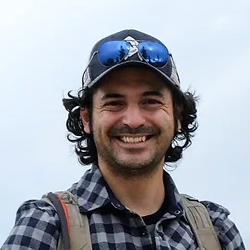What is a continuous glucose monitor and do I need one?

A continuous glucose monitor (CGM) is a device that monitors the body’s glucose levels in real-time. It consists of a sensor attached to a microfilament that inserts about five millimetres into the skin to access interstitial fluid where glucose can be measured.
The sensor can then deliver the collected data to a collection point — in many cases, a phone app. From there, users can monitor glucose levels in real-time, as well as trends over time, and interpret that data to make changes in diet, exercise, lifestyle, and sleep.
What is glucose and why does it matter to athletes?
Glucose is a simple sugar. Your body stores it in the muscles and in the liver, and when your muscles need more of it, your body will deliver the correct amount — unless you run low. “Glucose is fuel for your muscles,” says Phil Southerland, founder and CEO of Supersapiens, a CGM for athletes. “It’s the best measurement for brain and muscular function.”
That’s why it’s vital to maintain proper glucose levels and understand what fuels give your body the right amount when you need it. It’s possible to get too much glucose, too — which, in the long term, can lead to diabetes — and a CGM can help you understand when you need to raise or lower your levels.
“The body’s really good at giving you the glucose you need to do what you’re doing,” says Southerland. “If you go really hard, your glucose is going to spike. If you stop, the insulin reaction in your body will get you back to normal.”
That insulin reaction that causes a drop in glucose levels can make you feel weak or tired, says Southerland. By monitoring your glucose levels before, during, and after a workout, you can get a sense of when fueling helps you, when it might be causing an insulin reaction, and what fuels offer optimal levels at certain times of the day.

How does a Continuous Glucose Monitor work?
In order to get continuous glucose data, it’s necessary to wear a monitoring device over long periods of time. Supersapiens uses an adhesive patch to keep the glucose monitor in place on the back of the user’s arm.
Get instant access to breaking news, the hottest reviews, great deals and helpful tips.
The data gets collected into the sensor and then is transferred to the app, where users can see glucose levels either in real-time or trends over time.
“We get info on a minute-by-minute minute basis,” says Southerland. “You get the information now, as well as where it’s going. That means you can figure out what foods to put in your body, and at what times, to be your best self.”
Glucose and sleep
Glucose levels can have a significant impact on your sleep. And since sleep is the best recovery tool for athletes, it’s important to get it right.
To get the best sleep, Southerland says it’s crucial to find foods that will keep your glucose stable overnight. Spikes in glucose levels can lead to sleep instability, thereby inhibiting recovery.
Like performance-based analysis of glucose levels, when analyzing glucose level effects on your sleep, it’s important to note not just what foods affect you, but also when and how. “I worked with a 55-year-old female who rides a bike for her health,” Southerland says, “and she would get hypoglycemia during the night. She found that if she ate a handful of pumpkin seeds before bed, she got the best sleep she’d had in years.”
A CGM can help establish trends in a user’s diet that cause glucose spikes and/or insulin responses, and indicate what changes can be made to improve sleep patterns.
Do I need a CGM?
Whether you should invest in a CGM largely depends on what you’re trying to achieve. Athletes strive to be the best they can be in their given discipline, and a CGM will certainly give that athlete more information that helps them make better decisions about fueling strategies and sleep.
An athlete can view glucose levels in real-time during competition, which means that the athlete can tailor fueling strategies accordingly. If the numbers are dropping, the athlete may choose that moment to fuel up. If the numbers are higher than they should be, hydration might be the best course of action to bring glucose levels back down to normal.
Monitoring your glucose might simply make you feel better when you are exercising
If you’re not pursuing professional athletic glory at the highest levels of your sport, a CGM still provides many benefits. For starters, monitoring your glucose might simply make you feel better when you are exercising — which in turn may encourage you to exercise more. And if you’re having trouble with sleep consistency, a CGM could reveal some of the foods that are leading to those inconsistencies.
It’s also possible to disseminate some of the trend data to help you lose weight. “If you prevent glucose spikes when you’re not exercising,” Southerland says, “you’ll lose weight. If you stop eating foods that make your glucose go over [a certain level], you may lose a few pounds. And by losing weight, you can improve your power-to-weight ratio.”
As is the case with any health tracking tool, the information is only as good as the interpretation of it, and the actions you take based on it. A glucose monitor itself won’t help you gain an athletic or health advantage; making changes to your diet and other habits as a result of the information you receive from the glucose monitor certainly can.
More from Tom's Guide
- I did the 7-minute Bear Crawl exercise every day for a week — here are my results
- I hacked my metabolism using this continuous glucose monitor — here’s what happened
- I used this device to track my metabolism for a month — here’s what happened

Dan Cavallari is the former technical editor for VeloNews Magazine, who currently reviews electric bikes, bike lights, and other bike accessories for Tom's Guide. In addition to VeloNews, his work has appeared in Triathlete Magazine, Rouleur Magazine, CyclingTips.com, Road Bike Action, Mountain Bike Action, CycleVolta.com, Tomsguide.com, and much more. Dan also hosts two podcasts on his site, Slow Guy on the Fast Ride: One is about cycling and other outdoor activities, while the other looks at mental health issues. Most recently, Dan also covered the 2022 Tour de France. Dan lives outside of Denver, Colorado with his family.
